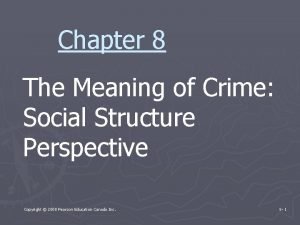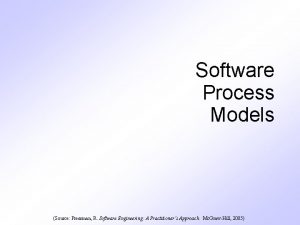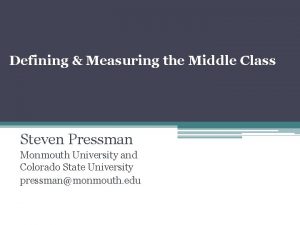Defining and Measuring the Middle Class Steven Pressman







- Slides: 7

Defining and Measuring the Middle Class Steven Pressman Comments by Anne Hartung, University of Luxembourg

The paper in a nutshell Aims • Epistemology/academic discourse: Find a “good measure of middle class” • Apply this definition to LIS data (and show its evolution over time? ) Contributions • Focus on the middle while most research looks at the bottom and the top of the income distribution • Critical, detailed review of different definitions and operationalisation of middle class • Evolution of middle class over a long period of time

Income-based definition of middle class • Two “categorical” approaches • Proportion of the distribution (between 20 th and 80 th percentile) • Percentage of median household income • Here: • Percentage of median household income • Based on Pew Survey (US, 2010) “How much income was necessary for a typical four person household to be middle class”: 67 -200% • Disposable household income • Cash and near-cash earnings, capital income, private income, public transfers, less direct taxes

Drawbacks of applied definition • Based on US perception of middle class 2010 – • but is the understanding of middle class (living standards) really constant over time (crisis? ) and across regions/neighbourhoods and countries? • The necessary income for middle class varies across time and countries, e. g. expenditures for housing, education, etc. • What is then the advantage relative to the first approach (middle quintiles)? • How arbitrary are these thresholds and what is the relative advantage to continuous measures of the middle class? Can this measure help to locate the middle class?

Income hierarchy in six countries Source: Luxembourg Income Study (LIS) Database Chauvel, L. 2016. The intensity and shape of inequality: The ABG method of distributional analysis. Review of Income and Wealth.

Ignored but important facets of middle class • Focusing on disposable income ignores important facets of middle class (which however can be estimated with the LIS data) • Growing relevance of wealth relative to income (Piketty 2014) • Housing prices relative to income (Mack and Martínez-García 2011, Bradbury 2013 using LWS) • Intra-household earnings ratio • Labour stability • …

Suggestions in sum Further potential to contribute to the debate: • Compare definitions against each other and point out implications (cf. aim of finding a “good measure”) • Relate empirical analysis to current debate on a broader range of aspects of middle class (possible with LIS) • Facilitate international comparison and relate to finding to Gornick and Jäntti (eds) 2013 Income Inequality: Economic Disparities and the Middle Class in Affluent Countries













